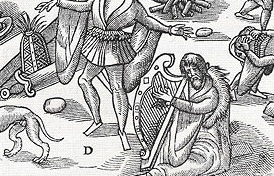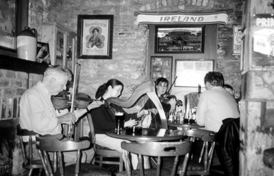So, harp students, what can you expect when taking harp lessons? Or, if you’re a teacher, what music lesson plans can you put together to keep life interesting? Here’s a simple list of six lesson plans for the harp from one of Stephanie’s current students. Any of these ideas could be modified to fit other instruments too!
1. Learn something by ear.
 Let’s face it… teachers are masters at their craft, and who doesn’t relish an opportunity to show off a little bit for their students? Why not offer your student an opportunity to listen to some of your tunes and pick one that they really get excited about? First, you have to play tunes that are fairly simple. It’s not like you can teach them Vivaldi’s “Four Seasons” in one sitting. Also, learning something by ear can take a while, and a lot of patience: but it’s an incredible social experience. For instance, I have learned songs from other harpers in one sitting, and now every time I play the song I think of that person—not a music book. I have also taught tunes to other musicians across instrument boundaries; one was a violin player, and I taught her an Irish tune “Basket of Turf”. We all have something valuable to pass on to anyone in the music world.
Let’s face it… teachers are masters at their craft, and who doesn’t relish an opportunity to show off a little bit for their students? Why not offer your student an opportunity to listen to some of your tunes and pick one that they really get excited about? First, you have to play tunes that are fairly simple. It’s not like you can teach them Vivaldi’s “Four Seasons” in one sitting. Also, learning something by ear can take a while, and a lot of patience: but it’s an incredible social experience. For instance, I have learned songs from other harpers in one sitting, and now every time I play the song I think of that person—not a music book. I have also taught tunes to other musicians across instrument boundaries; one was a violin player, and I taught her an Irish tune “Basket of Turf”. We all have something valuable to pass on to anyone in the music world.
Just for fun, here’s the tune I taught.
2. Work on old stuff.
I’ll be the first to admit, I learned some bad habits while I was away from a teacher. All of the pieces I’ve learned from my teenage years under a different teacher are now riddled with bad technique, and should probably be “relearned”. I can’t be the only one! I think it’s healthy to go back and work on those again, especially if you plan on using them for gigs. It’s a tough go, but don’t get discouraged. In the long run, it will help fortify the good technique.
3. Go on a field trip!
 If you can eke out the time, it’s another great experience with your student to go and see the instrument’s claim to fame locally or otherwise. It just so happens that the harp has a lot of footholds in Minnesota, including Redwing’s Stoney End—a workshop where they make harps and also sell a multitude of “exotic” instruments, and Musicmakers too—where they sell kits to build your own instrument (though that’s all online). If you’re in Chigaco, you can go visit the Lyon & Healy showroom. I’ve never been there, but I’ve always wanted to go.
If you can eke out the time, it’s another great experience with your student to go and see the instrument’s claim to fame locally or otherwise. It just so happens that the harp has a lot of footholds in Minnesota, including Redwing’s Stoney End—a workshop where they make harps and also sell a multitude of “exotic” instruments, and Musicmakers too—where they sell kits to build your own instrument (though that’s all online). If you’re in Chigaco, you can go visit the Lyon & Healy showroom. I’ve never been there, but I’ve always wanted to go.
Also, if you know of an upcoming performance where harp is featured, it might be fun to take your student to that as well—I for one am inspired when I see the talent being showcased. It makes me want to try really hard to be a good student, and master it myself.
4. Recitals.
 Yeah, everyone knows recitals should be included, but the students drag their feet. It’s HARD to get over the fear of public performance. Maybe it’s time that recitals were included more often in your lessons. I am personally a VERY shy person when it comes to music, and recitals were the bane of my existence when I played piano. What finally got me over it? I joined the Minnesota Renaissance Festival, and I performed non-stop for an 8-hour day—two days a week, two months out of the year. I am still afraid of getting up on a stage, but at least now I can play for a group of casual listeners with confidence. I know a renaissance festival isn’t close at hand for all teachers, but you might consider meeting your student at a busy park somewhere… park visitors are naturally curious, and they’ll come up and listen or talk—or they might be content to listen from a distance. Either way, it teaches students how to interact with interested patrons as well.
Yeah, everyone knows recitals should be included, but the students drag their feet. It’s HARD to get over the fear of public performance. Maybe it’s time that recitals were included more often in your lessons. I am personally a VERY shy person when it comes to music, and recitals were the bane of my existence when I played piano. What finally got me over it? I joined the Minnesota Renaissance Festival, and I performed non-stop for an 8-hour day—two days a week, two months out of the year. I am still afraid of getting up on a stage, but at least now I can play for a group of casual listeners with confidence. I know a renaissance festival isn’t close at hand for all teachers, but you might consider meeting your student at a busy park somewhere… park visitors are naturally curious, and they’ll come up and listen or talk—or they might be content to listen from a distance. Either way, it teaches students how to interact with interested patrons as well.
5. History.
 You’ll probably reserve this for your more mature students, but I can attest to being ravenous for historical information about the harp. I used to comb the web and books for any trivia regarding the harp, and I only wish I had more time—because I would probably write a college thesis on it if I could. I feel like understanding the musical evolution surrounding a person’s instrument of choice can be useful: one, because your listeners will ask you questions about it; and two, because it’s important that your student can empathize with & appreciate the journey that the instrument has taken to get to their hands.
You’ll probably reserve this for your more mature students, but I can attest to being ravenous for historical information about the harp. I used to comb the web and books for any trivia regarding the harp, and I only wish I had more time—because I would probably write a college thesis on it if I could. I feel like understanding the musical evolution surrounding a person’s instrument of choice can be useful: one, because your listeners will ask you questions about it; and two, because it’s important that your student can empathize with & appreciate the journey that the instrument has taken to get to their hands.
6. Sessions.
 Specifically, Irish Sessions. No instruction would be complete without some kind of exposure to playing well with others. I name Irish sessions because I have found them to be particularly forgiving and accepting of new players. Especially of the harp, since its reputation precedes it in Irish culture. First of all, let’s quickly define sessions. They are usually a group of mixed people that meet at an Irish pub. Now, I know—it’s a bar. Maybe not a great idea for a very young player. I was probably 20 when I joined my first session, but Irish pubs are generally family-friendly establishments, and I can guarantee the session members would be tickled pink over a fresh-faced harper. As long as the parents approve, and maybe even attend with the student, it can be a wonderful learning experience.
Specifically, Irish Sessions. No instruction would be complete without some kind of exposure to playing well with others. I name Irish sessions because I have found them to be particularly forgiving and accepting of new players. Especially of the harp, since its reputation precedes it in Irish culture. First of all, let’s quickly define sessions. They are usually a group of mixed people that meet at an Irish pub. Now, I know—it’s a bar. Maybe not a great idea for a very young player. I was probably 20 when I joined my first session, but Irish pubs are generally family-friendly establishments, and I can guarantee the session members would be tickled pink over a fresh-faced harper. As long as the parents approve, and maybe even attend with the student, it can be a wonderful learning experience.
Also, the session experience gives students and teachers alike a chance to practice a very important skill—that of being able to jump into the middle of songs while they are in progress. Session groups play a myriad of well-known Irish tunes, but usually it’s a tune “leader” that starts the song, and the rest of the players join in once they recognize it. I have found that to be a skill that I am not very good at, and the best way to learn is to practice.
Finally, if you can’t quite bring yourself to introduce sessions, I still maintain that learning with a group is an indispensable talent. Encourage your student to join a school orchestra or band. He or she can learn another set of skills including: timing, rhythm, tone & volume. You have to be heard, but it can’t be sloppy!
That’s it for now, but this is just an quick perspective from a current student. I’m sure there are more good ideas out there—do you have any? Let me know!
Emily is a student and friend of Stephanie’s, and helps with occasional harping/blogging enthusiasm.
Stephanie Claussen teaches harp lessons out of her home in St. Paul, Minnesota. She strives to ingrain in each student not only correct hand position, rhythm and a sense of musicality, but also a love for making music.

